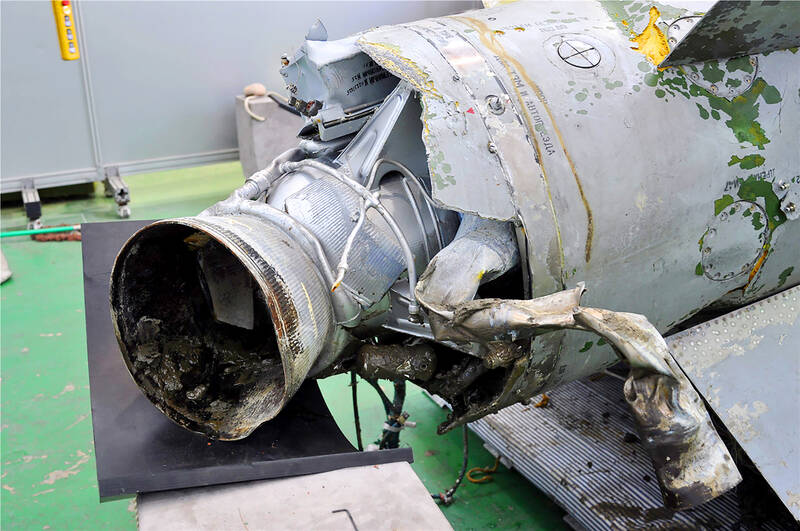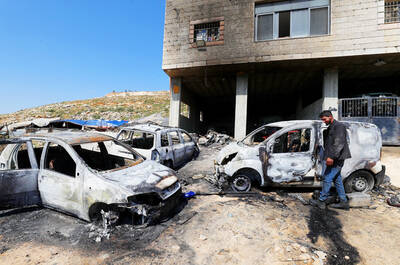North Korea yesterday fired a short-range ballistic missile toward its eastern sea, extending a recent barrage of weapons demonstrations, including what it described as simulated attacks on South Korean and US targets last week.
South Korea’s Joint Chiefs of Staff said the missile was launched from the western town of Sukchon, north of the capital, Pyongyang, and flew across the country toward waters off the North’s eastern coast.
The South Korean and Japanese militaries assessed that the missile flew about 250km to 290km at a maximum altitude of 30km to 50km. The relatively low trajectory seemed to align with the flight characteristics of some of North Korea’s newer short-range weapons designed to evade missile defenses.

Photo: AFP / South Korean Ministry of National Defense
Japanese Minister of Defense Yasukazu Hamada said the missile landed in waters outside of the country’s exclusive economic zone.
He said that North Korea’s intensifying testing activity was “significantly heightening” regional tensions and that Japan lodged a protest with the North through its embassies in Beijing.
The South Korean Ministry of Foreign Affairs said that its nuclear envoy, Kim Gunn, held separate telephone calls with his US and Japanese counterparts to discuss trilateral cooperation to counter North Korea’s increasing weapons tests and growing nuclear threat.
South Korean officials said the North could attempt to further raise pressure by conducting its first nuclear test since 2017 in the coming weeks.
The launch came after North Korea fired dozens of missiles last week in an angry reaction to a massive combined aerial exercise between the US and South Korea that the North described as an invasion rehearsal.
Earlier yesterday, South Korea’s military said the recovered debris of one of the North Korean missiles that flew southward last week was determined to be a Soviet-era anti-aircraft weapon that dates back to the 1960s.
The North’s military on Monday said that its launches last week were simulations to “mercilessly” strike key South Korean and US targets, such as air bases and operation command systems.
It said those tests included ballistic missiles loaded with dispersion warheads and underground infiltration warheads meant to launch strikes on enemy air bases, ground-to-air missiles designed to “annihilate” enemy aircraft at different altitudes and distances, and strategic cruise missiles that fell off South Korea’s southeastern coast.
The North described those launches as an appropriate response to the US and South Korea’s “Vigilant Storm” joint air force drills that wrapped up on Saturday, which involved about 240 warplanes, including B-1B supersonic bombers and advanced F-35 jets.
This week, the South Korean military has been conducting annual command post exercises meant to enhance crisis management and operational capabilities to cope with growing North Korean threats. The four-day training is to last until today.
The South Korean Ministry of National Defense yesterday said that an analysis of a 3m-long piece of wreckage fetched from waters near the Koreas’ eastern sea boundary on Sunday showed it was one of North Korea’s SA-5 surface-to-air missiles.
The ministry said a similar missile was used by the Russian military to execute ground attacks during its invasion of Ukraine.
Photographs released by the South Korean military show what appears to be a mangled rocket engine and wires sticking out from a broken rocket body that is still attached with fins.
The missile, which was one of more than 20 missiles North Korea fired on Wednesday last week, flew in the direction of a populated South Korean island and landed near the rivals’ tense sea border, triggering air raid sirens and forcing residents on Ulleung Island to evacuate.

Republican US lawmakers on Friday criticized US President Joe Biden’s administration after sanctioned Chinese telecoms equipment giant Huawei unveiled a laptop this week powered by an Intel artificial intelligence (AI) chip. The US placed Huawei on a trade restriction list in 2019 for contravening Iran sanctions, part of a broader effort to hobble Beijing’s technological advances. Placement on the list means the company’s suppliers have to seek a special, difficult-to-obtain license before shipping to it. One such license, issued by then-US president Donald Trump’s administration, has allowed Intel to ship central processors to Huawei for use in laptops since 2020. China hardliners

Conjoined twins Lori and George Schappell, who pursued separate careers, interests and relationships during lives that defied medical expectations, died this month in Pennsylvania, funeral home officials said. They were 62. The twins, listed by Guinness World Records as the oldest living conjoined twins, died on April 7 at the Hospital of the University of Pennsylvania, obituaries posted by Leibensperger Funeral Homes of Hamburg said. The cause of death was not detailed. “When we were born, the doctors didn’t think we’d make 30, but we proved them wrong,” Lori said in an interview when they turned 50, the Philadelphia Inquirer reported. The

RAMPAGE: A Palestinian man was left dead after dozens of Israeli settlers searching for a missing 14-year-old boy stormed a village in the Israeli-occupied West Bank US President Joe Biden on Friday said he expected Iran to attack Israel “sooner, rather than later” and warned Tehran not to proceed. Asked by reporters about his message to Iran, Biden simply said: “Don’t,” underscoring Washington’s commitment to defend Israel. “We are devoted to the defense of Israel. We will support Israel. We will help defend Israel and Iran will not succeed,” he said. Biden said he would not divulge secure information, but said his expectation was that an attack could come “sooner, rather than later.” Israel braced on Friday for an attack by Iran or its proxies as warnings grew of

A prominent Christian leader has allegedly been stabbed at the altar during a Mass yesterday in southwest Sydney. Bishop Mar Mari Emmanuel was saying Mass at Christ The Good Shepherd Church in Wakeley just after 7pm when a man approached him at the altar and allegedly stabbed toward his head multiple times. A live stream of the Mass shows the congregation swarm forward toward Emmanuel before it was cut off. The church leader gained prominence during the COVID-19 pandemic, amassing a large online following, Officers attached to Fairfield City police area command attended a location on Welcome Street, Wakeley following reports a number